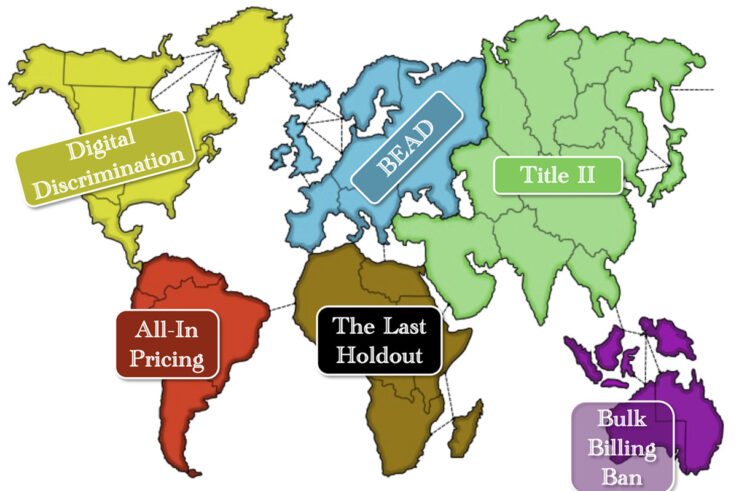This article is a part of the Section 2 Symposium symposium.
When I first started working in antitrust at the Justice Department over thirty years ago—there’s a hard reality to accept—the Antitrust Division was then embroiled in an effort to reform the regulation of oil pipelines. The argument on this now obscure issue was that effective prevention of the exercise of market power by natural monopoly pipelines required both clear pricing standards and effective separation of control of the pipeline capacity from the shippers who often owned the pipeline as well. Among other things, this led the Division to take an active role in the proceeding to set the rates to send oil through the Trans-Alaska Pipeline.
This largely forgotten issue had a much more consequential successor—the AT&T divestiture in 1984, settling an antitrust case filed a decade before. That case took the hard line that to prevent anticompetitive abuses, regulated monopolies and competitive services that rely upon them should rest in completely separate companies. Although the 1996 Telecommunications Act superseded that settlement, the principle of separating control of regulated assets from firms that compete in services that use those assets survives. The prominent example is electricity. Many state regulators ordered local distribution utilities to divest power plants, and federal regulators require that power transmission be supplied by regional organizations independent of the control of the competing generators that use them.
When Assistant Attorney General William Baxter announced the AT&T divestiture in 1982, he also announced that he was dropping, with prejudice, the even older antitrust case against IBM. The distinction was that AT&T operated in both regulated and unregulated sectors, while IBM did not. AT&T had an incentive to evade regulatory price constraints by creating an artificial competitive advantage by impeding its competitive market rivals’ access to its local service monopolies (“discrimination”). Moreover, depending on the form that regulation might take, the ability to shift costs from unregulated to regulated sectors may allow cost shifting enable a regulated firm may to make predatory threats credible (“cross-subsidization”). In the old AT&T case, this was called “pricing without regard to cost”.
Mr. Baxter’s distinction rested on the crucial point that regulation is a complement to antitrust, not a substitute. Absent regulation, refusals to deal are not presumptively harmful, and may be beneficial, while predatory threats are notoriously difficult to validate. This is why Mr. Baxter, no great hero to antitrust activists, famously pledged to litigate U.S. v. AT&T “to the eyeballs.” It may be important that the divestiture was the result of a settlement rather than a decided case. In any event, the crucial role of regulation appears to have been forgotten. When AAG Joel Klein announced a proposed divestiture remedy in U.S. v. Microsoft, he analogized the case to AT&T, despite nothing in Microsoft being regulated.
The nail in the U.S. v. AT&T coffin, however, was the unanimous opinion in 2004, backed by the enforcement agencies, in Verizon v. Trinko. Qualitatively, the allegations were the same as in U.S. v. AT&T, with local service providers needing access to regulated local loops taking the place of long distance providers needing access to local telephone service. Distinctions certainly could have been made on the basis of factual significance or standing—three justices relied on the latter. One might have appealed to statutory construction, but as the Trinko court recognized, the Telecommunications Act included an antitrust savings clause.
Instead, the Court reversed the position prevailing at the time of U.S. v AT&T and instead found the 1996 Telecommunications Act “a good candidate for implication of antitrust immunity,” stopped only by that savings clause. The view that regulation weakens rather than strengthens the need for antitrust enforcement was reinforced three years later in Credit Suisse v. Glen Billing, finding that antitrust enforcement should defer to SEC regulation.
The agencies’ interest in Trinko appears to have been understandably motivated by a desire to limit the reach of Aspen in basing monopolization on refusing to deal with competitors. Unfortunately, in leading courts to leave competition policy to sector-specific regulators, they drew the line in the wrong sand. Sector-specific agencies have an important job to do once they or Congress decides that competition in a sector will not work, to be replaced by regulation under a broad public interest standard. But that implies neither that the agencies have an interest in preserving competition in related unregulated markets, nor their inclination to focus on enhancing the economic performance of the sector as a whole.
Essential facilities cases are deservedly unpopular because antitrust courts are inappropriate price regulators. Should we continue to follow Trinko and leave antitrust enforcement to sectoral regulators—especially when regulation itself can facilitate anticompetitive conduct?




